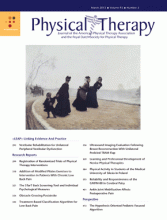Abstract
Background Obstacle crossing is impaired in people following stroke. It is not known whether people with stroke who fail an obstacle crossing task have more falls or whether the gait adjustments used to cross an obstacle differ from those used by people who pass the task.
Objective The purposes of this study were (1) to identify whether a group of people with stroke who failed an obstacle crossing task had a greater incidence of falling and (2) to determine whether people who fail an obstacle crossing task utilize different gait adjustments.
Design This was a prospective, observational study.
Methods Thirty-two participants with a recent stroke were recruited. Participants walked at self-selected speed and stepped over a 4-cm-high obstacle. Performance was rated as pass or fail, and spatiotemporal, center of mass (COM), and center of pressure (COP) data were collected. Prospective falls data were recorded for 20 participants over a 6-month period.
Results The incidence of fallers was significantly higher (incidence rate=0.833) in the group that failed the obstacle crossing task than in the group that passed the task (incidence rate=0.143). The group that failed the task had a slower walking speed and greater normalized separation between the trail heel (unaffected support limb) and COM as the affected lead toe cleared the obstacle. This group exhibited greater normalized times from affected lead toe clearance to landing, unaffected trail toe clearance to landing, and affected trail toe-off to toe clearance.
Limitations The sample size was small, and falls data were available for only 20 participants.
Conclusions Obstacle crossing is an important task to consider in people following stroke and may be useful in identifying those at risk of falls.
Footnotes
Dr Said and Dr Lythgo provided concept/idea/research design, writing, and data collection and analysis. Dr Said provided project management, fund procurement, and study participants. Dr Said and Dr Galea provided institutional liaisons. Dr Lythgo provided facilities/equipment and consultation (including review of manuscript before submission). The first data collection period was conducted in partial fulfillment of Dr Said's doctoral studies and was supervised by Dr Patricia Goldie and Professor Aftab Patla. The authors acknowledge the therapists who assisted in participant recruitment and the people who volunteered to participate in the study.
Study approval was provided by the Human Research Ethics Committees at Austin Health and La Trobe University (Austin Health Human Research Ethics Committee H99/00804, H2004/01939, La Trobe University Human Ethics Committee 99/148).
Dr Said received salary support from NHMRC Health Professional Training Fellowship Grant 310612 and NHMRC project grant 385002 and a Career Interruption Fellowship from the University of Melbourne. Financial support for the first data collection period was provided by the Victorian Branch Australian Physiotherapy Association, School of Physiotherapy, La Trobe University and La Trobe University Faculty of Health Sciences.
- Received May 15, 2012.
- Accepted October 9, 2012.












